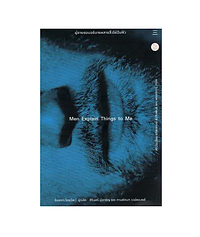Take a photo of a barcode or cover
challenging
inspiring
reflective
slow-paced
challenging
hopeful
informative
reflective
medium-paced
I didn’t need to know anything about the author to know she is a cis straight white woman.
There were too many instances of her writing that just screamed privilege- and not the kind that the person is aware of. As many others have pointed out, this book reads like basic feminism, but only “white” feminism, so don’t expect intersectionality from this collection of essays.
I also felt like her use of metaphors, similes, and imagery were flourishing horrible things too much and were, at times, done in poor taste.
I really really don’t recommend this book.
Trigger warning: sa, rape, violence, misogyny, suicide, racism
(honestly expect anything)
There were too many instances of her writing that just screamed privilege- and not the kind that the person is aware of. As many others have pointed out, this book reads like basic feminism, but only “white” feminism, so don’t expect intersectionality from this collection of essays.
I also felt like her use of metaphors, similes, and imagery were flourishing horrible things too much and were, at times, done in poor taste.
I really really don’t recommend this book.
Trigger warning: sa, rape, violence, misogyny, suicide, racism
(honestly expect anything)
dark
hopeful
informative
fast-paced
informative
inspiring
reflective
fast-paced
A very introductory book on (white) feminism. In 2024, the book does not offer itself too many new and revealing ideas (which is perhaps a good indication of the development of feminist movements). Moreover, I felt that with some of the cases Solnit only touched the surface of the issue, focusing on describing statistics and the existing status quo, while doing little to explore the core of the problem, what exactly it stems from (apart from throwing in a few buzzwords).
The essays are very uneven - some I quite liked (e.g. the one on Woolf), others were a waste of time for me, as I didn't get anything new out of them. And, of course, it's often purely white feminism at its finest, with little to no intersectionality. Solnit even compares Afgan woman wearing burqa to furniture/curtains.
What the book definitely loses out on for me is the lack of sources of the cited information. However, after reading the whole book, one learns in the acknowledgements that some sources for some of the texts existed - and that these can be found next to the original texts on the website. But that's not why I pick up a book and read it to look later for the same text on the internet to check whether the source of quoted information exist and if yes - from what exact source.
One issue is the lack of sources when citing e.g. cases of crime (I can take Solnit's word for it here that person A caused such and such damage to person B in locality X - although here too I would like to have a source), but what I find decidedly unacceptable is the lack of sources when making various kinds of estimates - e.g. writing about the information that in the USA a rape is reported approximately every six minutes (source?), but estimates says (whose estimates? Based on what premises? From when do these estimates come?) that the actual number of cases is probably five times higher. Especially that some statements made by Solnit are begging to be supported by adequate data before expressing them (for example ‘violence doesn't have a race, a class, a religion, or a nationality, but it does have a gender’). Or when a lack of sources makes it impossible to understand what the point is ("There has been no shortage of recent sex scandals in the United States with the same odour of arrogance around them, but at least they involved consensual sex (as far as we know, anyway)." - I have literally no idea what Solnit's scandals are about and I won't find it out from her). I had the impression that I was being inundated at times with a stream of stories and data (>95% of them without citing a source), after which the author proceeds to justify that, admittedly, some men do behave this way, BUT NOT ALL MEN, and let us remember that there are good men. After which she offers an explanation of the problem in a few sentences, again without giving any scientific basis for her proposed explanations - which could still be acceptable to me (after all, I'm not reading a scientific article) if these explanations had depth and really tried to explain something. Whereas this is often just throwing up a few empty clichés.
Maybe it is a good book as an introduction to (white) feminism. However, in my opinion people with at least some knowledge on the subject (and not even with knowledge from book sources, but even from feminist accounts on instagram or tiktok) are unlikely to get much out of this book.
The essays are very uneven - some I quite liked (e.g. the one on Woolf), others were a waste of time for me, as I didn't get anything new out of them. And, of course, it's often purely white feminism at its finest, with little to no intersectionality. Solnit even compares Afgan woman wearing burqa to furniture/curtains.
What the book definitely loses out on for me is the lack of sources of the cited information. However, after reading the whole book, one learns in the acknowledgements that some sources for some of the texts existed - and that these can be found next to the original texts on the website. But that's not why I pick up a book and read it to look later for the same text on the internet to check whether the source of quoted information exist and if yes - from what exact source.
One issue is the lack of sources when citing e.g. cases of crime (I can take Solnit's word for it here that person A caused such and such damage to person B in locality X - although here too I would like to have a source), but what I find decidedly unacceptable is the lack of sources when making various kinds of estimates - e.g. writing about the information that in the USA a rape is reported approximately every six minutes (source?), but estimates says (whose estimates? Based on what premises? From when do these estimates come?) that the actual number of cases is probably five times higher. Especially that some statements made by Solnit are begging to be supported by adequate data before expressing them (for example ‘violence doesn't have a race, a class, a religion, or a nationality, but it does have a gender’). Or when a lack of sources makes it impossible to understand what the point is ("There has been no shortage of recent sex scandals in the United States with the same odour of arrogance around them, but at least they involved consensual sex (as far as we know, anyway)." - I have literally no idea what Solnit's scandals are about and I won't find it out from her). I had the impression that I was being inundated at times with a stream of stories and data (>95% of them without citing a source), after which the author proceeds to justify that, admittedly, some men do behave this way, BUT NOT ALL MEN, and let us remember that there are good men. After which she offers an explanation of the problem in a few sentences, again without giving any scientific basis for her proposed explanations - which could still be acceptable to me (after all, I'm not reading a scientific article) if these explanations had depth and really tried to explain something. Whereas this is often just throwing up a few empty clichés.
Maybe it is a good book as an introduction to (white) feminism. However, in my opinion people with at least some knowledge on the subject (and not even with knowledge from book sources, but even from feminist accounts on instagram or tiktok) are unlikely to get much out of this book.
amazing set of essays. learned a lot and really enjoyed the writing. loved the intersection of feminism and place.
challenging
informative
reflective
medium-paced






